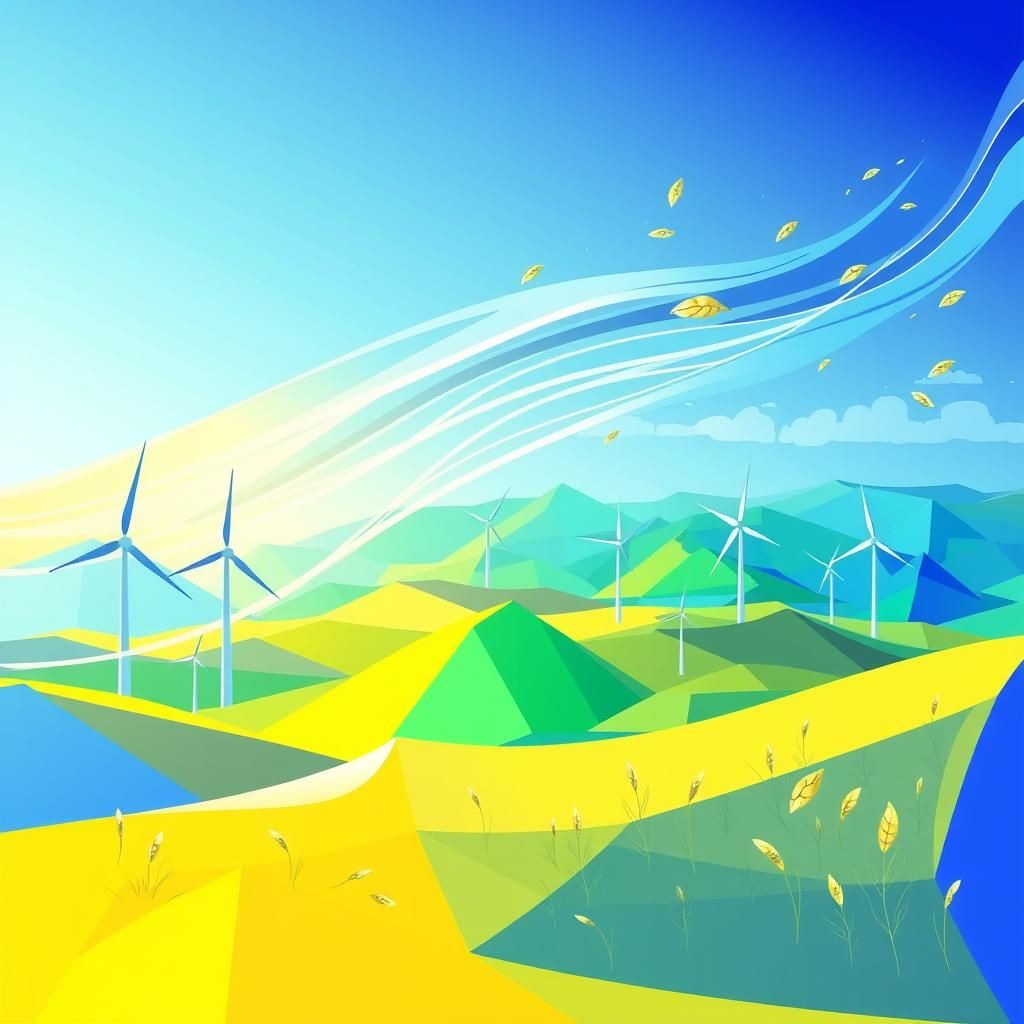
Explore & Play
Discover interesting topics and solve the accompanying crossword puzzle.
Wind crossword: Exploring Winds from Breezes to Hurricanes
Table of Contents
Wind crossword
You can either fill in the crossword puzzle directly on this page or click the button in the bottom right corner to print it for free.
——————————————
Understanding Wind: From Gentle Breezes to Powerful Hurricanes and Resilient Turbines

Introduction
Wind is more than just the air moving around us—it’s a powerful force shaping our world every day. At its core, wind is simply air on the move, pushed by differences in temperature and pressure across the planet. From a soft breeze that cools your face on a hot day to the fierce gusts that whip through a storm, wind touches everything. It carries seeds, powers turbines, influences weather patterns, and sometimes, when cranked up to extreme levels, can change the course of history.
Understanding wind isn’t just for weather reporters or scientists. It matters to anyone planning a picnic, designing buildings, or living near the coast. Knowing how wind works helps us harness its energy, forecast storms, and stay safe when nature flexes its muscles. In a world racing toward cleaner energy and smarter cities, grasping the basics of wind is our launchpad into a future where we live not against nature, but with it.

Types of Wind: From Breezes to Storms
Wind isn’t just one thing—it’s a whole spectrum, ranging from the tender touch of a breeze to the full-throttle fury of a hurricane. Understanding these variations is key, whether you’re walking your dog or bracing for a storm.
Gentle Winds: Breezes and Gales
Think of breezes as wind’s chill, easy-going cousin. They’re steady, gentle, and make a hot day bearable—like the wind casually reminding you it’s there. Usually clocking in below 15 mph, breezes rustle leaves and flutter hair, but rarely cause trouble.
Gales, on the other hand, turn up the volume. These winds push between 39 and 54 mph, often giving you a warning before a storm rolls in. Imagine walking against a persistent wind that’s firm enough to nudge you backward—that’s a gale. They don’t just move air; they stir the atmosphere, setting the stage for more serious weather.
Sudden Wind Changes: Gusts
Gusts are wind’s surprise attacks. One moment the air feels calm, then—bam—a sudden spike in speed. These bursts can reach over 30 mph higher than the average wind and are notorious for catching people off guard. Gusts pack the punch in storms, rattling windows and snapping branches. They’re the reason your umbrella flips inside out or your hat takes flight.
Severe Winds: Storms, Hurricanes, Tornadoes, and Cyclones
When wind goes big, it becomes a force that reshapes landscapes and tests human ingenuity. Severe storms crank wind speeds way beyond what most of us can picture—think over 74 mph for hurricanes, up to 200 mph or more for tornadoes.
Hurricanes swirl over warm oceans, building energy like a monster engine, then roar ashore with sustained winds exceeding 110 mph. The 2025 Atlantic hurricane season is tipped to churn out 13-19 named storms, including 3-5 major hurricanes. That means communities need to stay on high alert.
Tornadoes are the speed demons of the wind world—smaller in scale but packing a punch with spinning winds that can blast past 200 mph in a tight, twisting column. Cyclones are like hurricanes’ siblings, spinning over the Indian and South Pacific Oceans with their own fury.
Each severe wind type comes with unique behavior and hazards, but they all demand respect. They’re reminders of nature’s raw power and why understanding wind isn’t just interesting—it’s essential.

Measuring Wind: Technologies and Challenges
When it comes to measuring wind, it’s tempting to picture the old-school weather vane spinning atop a barn. Sure, it points which way the wind blows, but that’s about all it does. The myth that a weather vane can predict rain? Straight-up fiction. It’s a direction pointer, not a crystal ball.
For tracking how fast the wind blows, anemometers have been the go-to gadgets for decades. Think of them like the speedometer of the sky, with little cups that catch the breeze and spin faster as the wind picks up. They’re reliable but have their limits — especially when the wind turns wild and unpredictable.
Enter the new generation: ultrasonic anemometers. These sleek devices don’t have moving parts. Instead, they zap ultrasonic pulses between sensors and measure how wind speed changes the time it takes for the pulses to travel. It’s like sending secret messages through the air and timing how the wind interrupts them. This makes ultrasonic anemometers faster, more accurate, and tougher against wear—perfect for catching those sudden gusts and shifts.
But here’s where things get tricky. Measuring tornado winds, especially near the ground, is like trying to catch lightning in a jar. The winds twist and surge in violent, chaotic patterns that challenge even the most advanced instruments. Radar and drones are stepping up the game, flying close to storms and feeding scientists real-time data. Still, the intensity and danger make it an ongoing challenge.
The future? Smart networks of sensors, AI-driven analysis, and drones teaming up to paint a clearer, faster picture of wind behavior. Because understanding wind isn’t just about weather geeks; it’s about saving lives, protecting communities, and designing the machines that will power our clean energy future.

Impact of Storm Winds on Environment and Society
When storms hit, it’s not just a bad day with messy hair — wind can reshape landscapes and lives in a flash. Hurricanes, tornadoes, and cyclones pack punchy winds that tear through communities, uprooting trees, flattening buildings, and knocking out power lines. These aren’t just inconvenient events; they’re powerful natural disasters that demand respect and preparation.
Take hurricanes, for example. Winds blowing north of 110 mph don’t just rattle windows — they can flood entire coastal towns, wash away roads, and disrupt ecosystems for years. Tornadoes? Those spinning funnels might be smaller in size but deliver wind speeds that outpace most hurricanes, making their path of destruction brutal and fast.
But here’s the twist: these storms also reshape nature. Flooded wetlands can become new habitats, and forests blown down by strong winds make room for fresh growth. It’s a harsh reset button — a reminder that wind is both destroyer and creator.
This is why accurate wind monitoring isn’t optional; it’s critical. Advanced sensors and real-time data feed early warning systems, giving people crucial minutes, sometimes hours, to secure homes and evacuate. The better we measure and predict wind behavior, the better we can protect lives and reduce damage.
Storm winds will keep coming. Understanding their power and patterns is our best shot at staying one step ahead.

Wind Turbines and Resilience Against Extreme Weather
When hurricanes roar and storms batter coastlines, wind turbines stand right in the eye of the chaos. That’s a tough spot to be in. But engineers aren’t just crossing their fingers and hoping the blades hold up. They’re turning to nature for brilliant fixes — and the results are nothing short of futuristic.
Take palm trees, for example. These trees don’t snap in strong winds; they bend, sway, and absorb the force. Inspired by this, turbine designers have crafted blades and towers that flex instead of break. It’s like giving a turbine a built-in shock absorber, letting it ride out the storm rather than fight it head-on.
Then there’s blade feathering. Imagine your hand in the wind — hold it flat and it catches a lot of air; tilt it and the wind slips past more easily. Turbines use this same trick. When a hurricane hits, blades turn their edges to minimize resistance, drastically cutting down the stress and wear. This simple angle tweak can make the difference between crushing failure and stubborn survival.
But even with these smart designs, the battle isn’t over. Tropical storms pack power far beyond what turbines usually face. Gusts can spike suddenly, and debris can strike like missiles. This ongoing challenge pushes researchers to keep improving materials and control systems, aiming for turbines that don’t just survive storms but keep delivering clean energy in their wake.
The future of wind power is about blending resilience with efficiency — turbines that learn from nature, adapt on the fly, and stand tall no matter what the weather throws at them. Imagine wind farms swaying gracefully during a hurricane, still humming with energy as the world outside howls. That’s a future worth building toward.

Common Myths and Facts About Wind
Let’s clear the air on some wind myths that still hang around like a stubborn breeze. First up: weather vanes. You’ve probably seen those classic arrow-shaped gadgets spinning atop barn roofs and thought, “If it’s pointing south, rain’s coming, right?” Nope. Weather vanes simply show which way the wind is blowing—no magic rain prediction powers included. They’re like signposts for wind direction, not fortune tellers.
Now, about wind terminology—this stuff matters because mixing up a breeze and a gale is like confusing a toothbrush with a chainsaw. A breeze is gentle, steady, and just enough to ruffle your hair; a gale is a serious step up—strong, sometimes warning us that a storm’s on the way. Then we have gusts, which are those sudden, sharp blasts that catch you off guard and shake tree branches like they’re doing jazz hands.
When storms crank up, winds turn fierce—storm, hurricane, tornado, cyclone—they’re siblings but not twins. Hurricanes and cyclones are basically the same beast, just different names depending on the ocean where they form. Tornadoes? They’re smaller but pack a punch like a heavyweight champ in a phone booth.
So, get your terms straight, and you’re already a step ahead. Wind isn’t just air on the move—it’s a language of nature, one that helps us understand weather, prepare for storms, and harness energy. And knowing which word fits keeps us sharp when the winds start to blow.

Conclusion
Wind shapes our world in powerful and surprising ways—from the soft touch of a morning breeze to the raw fury of a hurricane. We’ve seen how wind comes in many forms, each with its own fingerprint on the environment and society. Measuring wind isn’t just about numbers; it’s about staying safe and ready, especially when the winds turn fierce.
On the energy front, wind turbines are evolving fast. Inspired by nature’s flexibility and armed with smart tech like blade feathering, they’re standing stronger against storms than ever before. This dance between human innovation and nature’s force is where the future of clean energy lies.
Looking ahead, understanding wind better means safer communities and smarter energy. As turbines get tougher and measurement tools get sharper, we’re not just chasing the wind—we’re learning to work with it. The horizon is bright, and the next gust might just carry the breakthrough we need.
Ready to dig deeper? Check out the resources below for the full lowdown on wind science and tech innovation. The future’s blowing in—and it’s looking exciting.
Share to...
I hope you enjoy the content.
Want to receive our daily crossword puzzle or article? Subscribe!
You may also be interested in
Share to…
Want to receive our daily crossword puzzle?
-
Jigsaw Puzzles
Chinese Zodiac Serpent Watercolor Jigsaw Puzzle 250 | 300 | 500 Pieces
kr 348,00 – kr 439,00Price range: kr 348,00 through kr 439,00 Select options This product has multiple variants. The options may be chosen on the product page -
Jigsaw Puzzles
Zodiac Ink Art Puzzle: The Playful Monkey 250 | 300 | 500 Pieces
kr 348,00 – kr 439,00Price range: kr 348,00 through kr 439,00 Select options This product has multiple variants. The options may be chosen on the product page -
Jigsaw Puzzles
Enchanting Four Sheep Zodiac Jigsaw Puzzle 250 | 300 | 500 Pieces
kr 348,00 – kr 439,00Price range: kr 348,00 through kr 439,00 Select options This product has multiple variants. The options may be chosen on the product page

















